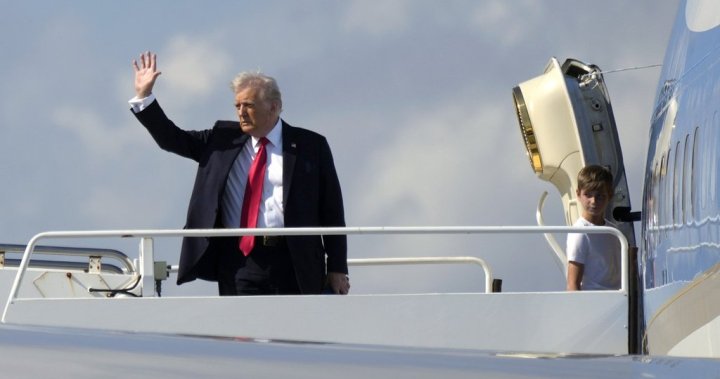Canada
Trump’s tariffs on steel, aluminum echo familiar playbook: A timeline

U.S. Tariffs on Canadian Steel and Aluminum: A Familiar Challenge for Canadian Industries
The decision by U.S. President Donald Trump to reimpose tariffs on foreign steel and aluminum imports has sent shockwaves through Canadian industries, evoking a strong sense of déjà vu. This is not the first time Trump has taken such measures, as a similar situation unfolded in 2018 during the renegotiation of the North American Free Trade Agreement (NAFTA), which eventually led to the Canada-United States-Mexico Agreement (CUSMA). The current tariffs are part of an even more aggressive strategy by Trump, which is likely to influence the upcoming CUSMA review in 2026. For now, Canada and Mexico are working to avoid broader tariffs on all exports to the U.S., which have been temporarily halted until March. The situation mirrors the events of 2018, when Trump used tariffs as leverage during trade negotiations, causing significant disruption to industries on both sides of the border.
The 2018 Tariffs and the Path to CUSMA
The story of the 2018 tariffs began in March of that year, when Trump announced a 25% tariff on foreign steel imports and a 10% tariff on aluminum imports, citing national security concerns and the need to protect American producers. At the time, Trump linked the tariffs to the ongoing NAFTA renegotiations, suggesting that Canada and Mexico could avoid the tariffs by agreeing to a "new & fair NAFTA agreement." Initially, Canada and Mexico were exempt from the tariffs, but this exemption was only temporary. By May 31, 2018, the tariffs were implemented, prompting Canada to impose retaliatory tariffs on $16.6 billion worth of U.S. exports, targeting products such as steel, aluminum, and American whiskey. The retaliatory measures were carefully designed to impact key Republican-leaning states, putting political pressure on Trump to reconsider his approach.
The Economic and Human Impact of the Tariffs
The tariffs had a profound impact on Canadian industries, particularly in the steel and aluminum sectors. Steel exports to the U.S. fell by 38% in June 2018, and by May 2019, they were at their lowest level in nearly a decade. Aluminum exports also suffered, dropping by an average of 19% per month during the year the tariffs were in place, with an overall decline of over 50%. The human cost was equally significant, with Canadian workers facing layoffs and production changes. For example, Tenaris SA, a steel pipe manufacturer in Sault Ste. Marie, Ontario, temporarily laid off 40 workers and reorganized its production in response to the tariffs. These developments underscored the delicate balance of trade relationships and the potential consequences of punitive measures like tariffs.
The Road to CUSMA and the Lifting of Tariffs
Despite the challenges posed by the tariffs, Canada, the U.S., and Mexico eventually reached a deal on September 30, 2018, with the signing of the United States-Mexico-Canada Agreement (USMCA), known as CUSMA in Canada. The deal was formally signed by Trump, Canadian Prime Minister Justin Trudeau, and outgoing Mexican President Enrique Peña Nieto at the G20 summit in Buenos Aires, Argentina, on November 30, 2018. However, the steel and aluminum tariffs remained in place until May 17, 2019, when the U.S. and Canada announced an agreement to lift the tariffs, along with Canada’s retaliatory measures. The deal was a relief for industries on both sides of the border, and Canada quickly moved to ratify CUSMA, which officially came into effect on July 1, 2020.
**The Resurgence of Tarif
-

 Money3 days ago
Money3 days agoConsumer Financial Protection Bureau Adds Error Message To Home Page
-

 Australia1 day ago
Australia1 day agoTropical Cyclone Zelia intensifies to category 2 storm
-

 Money2 days ago
Money2 days agoWinning Content Strategies For Wealth Managers
-

 Asia1 day ago
Asia1 day agoWhat you need to know about 2024 YR4, the asteroid that could hit Earth in about eight years’ time
-

 Entertainment16 hours ago
Entertainment16 hours agoPrince Harry and Meghan Markle’s Best Moments and Photos From the 2025 Invictus Games
-

 Australia11 hours ago
Australia11 hours agoTropical Cyclone Zelia intensifies to category five system off Pilbara coast
-

 Politics1 day ago
Politics1 day agoDozens of religious groups sue to stop Trump admin from arresting migrants in places of worship
-

 Entertainment3 days ago
Entertainment3 days agoEvery Celebrity Who Attended the 2025 Super Bowl: A Guide to the A-Listers at the Big Game









